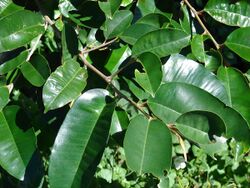Biology:Chrysophyllum
| Chrysophyllum | |
|---|---|

| |
| Chrysophyllum oliviforme | |
| Scientific classification | |
| Kingdom: | Plantae |
| Clade: | Tracheophytes |
| Clade: | Angiosperms |
| Clade: | Eudicots |
| Clade: | Asterids |
| Order: | Ericales |
| Family: | Sapotaceae |
| Subfamily: | Chrysophylloideae |
| Genus: | Chrysophyllum L. (1753)[1] |
| Synonyms[1] | |
| |
Chrysophyllum is a group of trees in the Sapotaceae described as a genus by Linnaeus in 1753.[2][3]
The genus is native to the tropical Americas, from Mexico to northern Argentina, including the Caribbean.[1] One species, C. oliviforme, extends north to southern Florida.[4][1]
Description
Chrysophyllum members are usually tropical trees, often growing rapidly to 10–20 m or more in height. The leaves are oval, 3–15 cm long, green above, densely golden pubescent below, from which the genus is named.[5] The flowers are small (3–8 mm), purplish white and have a sweet fragrant smell; they are clustered several together, and are hermaphroditic (self fertile). The fruit is edible; round, usually purple skinned (sometimes greenish-white), often green around the calyx, with a star pattern in the pulp; the flattened seeds are light brown and hard. The fruit skin is chewy like gum, and contrary to some reports, is edible. [citation needed][6][7]
Species
Currently accepted species include:[1]
- Formerly included[1]
- Donella ambrensis Aubrév. (as C. ambrense (Aubrév.) G.E.Schatz & L.Gaut.)
- Donella analalavensis Aubrév. (as C. analalavense (Aubrév.) G.E.Schatz & L.Gaut.)
- Donella bangweolensis (R.E.Fr. & Pellegr.) Mackinder (as C. bangweolense R.E.Fr. & Pellegr.)
- Donella capuronii (G.E.Schatz & L.Gaut.) Mackinder & L.Gaut. (as C. capuronii G.E.Schatz & L.Gaut.)
- Donella delphinensis Aubrév. (as C. delphinense (Aubrév.) G.E.Schatz & L.Gaut.)
- Donella fenerivensis Aubrév. (as C. fenerivense (Aubrév.) G.E.Schatz & L.Gaut.)
- Donella guereliana (Aubrév.) Mackinder (as C guerelianum (Aubrév.) G.E.Schatz & L.Gaut.)
- Donella masoalensis Aubrév. (as C. masoalense (Aubrév.) G.E.Schatz & L.Gaut.)
- Donella perrieri Lecomte (as C. perrieri (Lecomte) G.E.Schatz & L.Gaut.)
- Donella pruniformis (Engl.) Pierre ex Engl. (as C. pruniforme Engl.)
- Donella viridifolia (J.M.Wood & Franks) Aubrév. & Pellegr. (as C. viridifolium J.M.Wood & Franks)
- Donella ubangiensis (De Wild.) Aubrév. (as C. ubangiense (De Wild.) Govaerts)
- Englerophytum longepedicellatum (De Wild.) L.Gaut. (as C. longifolium De Wild.)
- Englerophytum magalismontanum (Sond.) T.D.Penn. (as C. magalismontanum Sond.)
- Englerophytum oblanceolatum (S.Moore) T.D.Penn. (as C. tessmannii Engl. & K.Krause)
- Gambeya africana - (A.DC.) Pierre (as C. africanum A.DC.)
- Gambeya albida (G.Don) Aubrév. & Pellegr. (as C. albidum G.Don)
- Gambeya azaguieana (J.Miège) Aubrév. & Pellegr. (as C. azaguieanum J.Miège)
- Gambeya beguei (Aubrév. & Pellegr.) Aubrév. & Pellegr. (as C. beguei (Aubrév. & Pellegr.) Aubrév. & Pellegr.)
- Gambeya boiviniana Pierre (as C. boivinianum (Pierre) Baehni)
- Gambeya boukokoensis Aubrév. & Pellegr. (as C. boukokoense (Aubrév. & Pellegr.) L.Gaut.)
- Gambeya gigantea (A.Chev.) Aubrév. & Pellegr. (as C. giganteum A.Chev.)
- Gambeya gorungosana (Engl.) Liben (as C. gorungosanum Engl.)
- Gambeya lacourtiana (De Wild.) Aubrév. & Pellegr. (as C. lacourtianum De Wild.)
- Gambeya lungi (De Wild.) Aubrév. & Pellegr. (as C. lungi De Wild.)
- Gambeya muerensis (Engl.) Liben (as C. muerense Engl.)
- Gambeya taiensis (Aubrév. & Pellegr.) Aubrév. & Pellegr. (as C. taiense Aubrév. & Pellegr.)
- Jacquinia arborea Vahl (as C. barbasco Loefl.)
- Micropholis rugosa (Sw.) Pierre (as C. rugosum Sw.)
- Palaquium philippense (Perr.) C.B.Rob. (as C. philippense Perr.)
- Pouteria alnifolia (Baker) Roberty (as C. alnifolium Baker)
- Pouteria gardneri (Mart. & Miq.) Baehni (as C. gardneri Mart. & Miq.)
- Pouteria macrophylla (Lam.) Eyma (as C. macrophyllum Lam.)
- Pouteria reticulata (Engl.) Eyma (as C. reticulatum Engl.)
- Pradosia brevipes (Pierre) T.D.Penn. (as C. soboliferum Rizzini)
- Pradosia lactescens (Vell.) Radlk. (as C. burahem Riedel)
References
- ↑ 1.0 1.1 1.2 1.3 1.4 1.5 Chrysophyllum L. Plants of the World Online, Kew Science. Accessed 5 June 2023.
- ↑ Linnaeus, Carl von. 1753. Species Plantarum 1: 192 in Latin
- ↑ Tropicos, Chrysophyllum L.
- ↑ Chrysophyllum L. World Flora Online. Accessed 3 December 2022.
- ↑ The generic name is derived from the Greek words χρυσός (chrysos), meaning "gold," and φυλλον (phyllos), meaning "leaf." See Quattrocchi, Umberto (2000). CRC World Dictionary of Plant Names. I A-C. CRC Press. p. 534. ISBN 978-0-8493-2675-2. https://books.google.com/books?id=esMPU5DHEGgC.
- ↑ Flora of North America Vol. 8 Page 245 Cainito Chrysophyllum Linnaeus
- ↑ Flora of China, Vol. 15 Page 208 金叶树属 jin ye shu shu Chrysophyllum Linnaeus
Wikidata ☰ Q2105812 entry
 |

